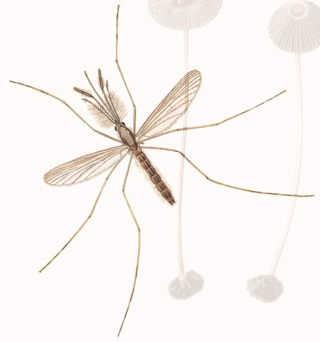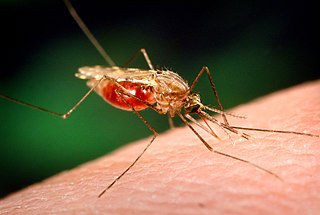
Anopheles is a genus of mosquito first described by J. W. Meigen in 1818, and are known as nail mosquitoes and marsh mosquitoes. Many such mosquitoes are vectors of the parasite Plasmodium, a genus of protozoans that cause malaria in birds, reptiles, and mammals, including humans. The Anopheles gambiae mosquito is the best-known species of marsh mosquito that transmits the Plasmodium falciparum, which is a malarial parasite deadly to human beings; no other mosquito genus is a vector of human malaria.

Anopheles culicifacies is a mosquito species complex and one of the primary vectors of malaria on the Indian subcontinent. It consists of five sibling species, provisionally designated as species A, B, C, D, and E. It prefers to rest indoors in cattle sheds, where it feeds on cattle. The control of A. culicifacies has become difficult due to the development of insecticide resistance against all commonly used insecticides, including new-generation insecticides such as synthetic pyrethroids.
Anopheles (Cellia) subpictus is a species complex of four species of mosquito belonging to the genus Anopheles.

Anopheles albimanus is a species of mosquito in the order Diptera. It is found in coastal Central and South America, the Caribbean, and Mexico. It is a generalist species and capable of wide dispersion. A. albimanus is a common malaria vector.

Anopheles stephensi is a primary mosquito vector of malaria in urban India and is included in the same subgenus as Anopheles gambiae, the primary malaria vector in Africa. A. gambiae consists of a complex of morphologically identical species of mosquitoes, along with all other major malaria vectors; however, A. stephensi has not yet been included in any of these complexes. Nevertheless, two races of A. stephensi exist based on differences in egg dimensions and the number of ridges on the eggs; A. s. stephensisensu stricto, the type form, is a competent malaria vector that takes place in urban areas, and A. s. mysorensis, the variety form, exists in rural areas and exhibits considerable zoophilic behaviour, making it a poor malaria vector. However, A. s. mysorensis is a detrimental vector in Iran. An intermediate form also exists in rural communities and peri-urban areas, though its vector status is unknown. About 12% of malaria cases in India are due to A. stephensi.

Anopheles claviger is a mosquito species found in Palearctic realm covering Europe, North Africa, northern Arabian Peninsula, and northern Asia. It is responsible for transmitting malaria in some of these regions. The mosquito is made up of a species complex consisting of An. claviger sensu stricto and An. petragnani Del Vecchio. An. petragnani is found only in western Mediterranean region, and is reported to bite only animals; hence, it is not involved in human malaria.

Anopheles sinensis is a species of mosquito that transmits malaria as well as lymphatic filariasis. It is regarded as the most important vector of these human parasitic diseases in Southeast Asia. It is the primary vector of vivax malaria in many regions. In China it also transmits the filalarial parasite, and arthropod roundworm. In Japan it is also a vector of a roundworm Setaria digitata in sheep and goats.

Anopheles annularis is a species of mosquito belonging to the genus Anopheles. Larvae found in clean, lotic bodies of water with abundant vegetation. Females are zoophilic, mainly feed blood on cattle and humans. The species is a major malaria vector in India, Nepal and Sri Lanka. It is also an important vector for Plasmodium vivax in Afghanistan.

Anopheles barbirostris is a species complex of mosquito belonging to the genus Anopheles. Larvae found in clean, lotic bodies of water. Females are zoophilic, mainly feed blood on cattle and humans. It is also an important vector for Plasmodium falciparum in Sri Lanka and Timor, for both Plasmodium vivax and P. falciparum in Bangladesh.
Anopheles elegans is a species complex of mosquito belonging to the genus Anopheles. It is found in India and Sri Lanka. In India, it is known to breed in shaded stagnant waters and tree holes. It is a natural vector of simian malaria in both countries.
Anopheles (Cellia) karwari is a species complex of zoophilic mosquito belonging to the genus Anopheles. It is found in India, and Sri Lanka, Bangladesh, Sumatra, and Java. A. karwari is a member of the Maculatus Group and the second scarcest species reported from Indonesia. Female is blood sucking and involved in transmitting Plasmodium falciparum, thus an important malarial vector. It is considered a secondary vector in the Australian region, but its vectorial status in South-East Asia was unknown.
Anopheles (Anopheles) nigerrimus is a species complex of zoophilic mosquito belonging to the genus Anopheles. It belongs to the Nigerrimus Subgroup and Hyrcanus Group of the Myzorhynchus Series. It is found in India, and Sri Lanka, Bangladesh, Brunei, Cambodia, China, Malaysia, Myanmar, Nepal, Pakistan, Thailand, and Vietnam. It is a Possible malaria and filariasis vector. It is found from ecosystems nearby water courses such as rice fields, canals, large open marshes, and also in partially sunny, shady deep pools with floating vegetation. In Sri Lanka, the adult and larval stages are known to show resistant to a range of organophosphate and carbamate insecticides. Cytologically, two karyotypic forms of A. nigerrimus are identified, as Form A and B.
Anopheles pallidus is a species complex of mosquito belonging to the genus Anopheles. It is found in India, and Sri Lanka and Myanmar. It is a potential natural vector of bancroftian filariasis in Sri Lanka as well as Malaria and Babesiosis in other countries.
Anopheles (Anopheles) peditaeniatus is a species complex of mosquito belonging to the genus Anopheles, of the Hyrcanus Group. It is found in India, and Sri Lanka, Iran, and Bangladesh. It is a potential natural vector of bancroftian filariasis in Sri Lanka.
Anopheles (Cellia) tessellatus is a species complex of zoophilic mosquito belonging to the genus Anopheles. It is found in India, and Sri Lanka, Bangladesh, Cambodia, China, Indonesia, Malaysia, Laos, Maldives, Myanmar, Nepal, Philippines, Taiwan, Thailand and Vietnam. It is first described from Sri Lanka. Larvae are known to found from dirty stagnant water in sun or shady habitats. Adults are zoophilic. It is not regarded as a malaria vector, but is a secondary vector of Wuchereria bancrofti in Maldives.
Anopheles (Cellia) vagus is a species complex of zoophilic mosquito belonging to the genus Anopheles. It is found in India, Sri Lanka and Indonesia. It is a potential natural vector of malarial parasite Plasmodium falciparum, and Japanese encephalitis virus. It is highly susceptible to insecticide deltamethrin and resistant to DDT.
Anopheles (Cellia) varuna is a species complex of zoophilic mosquito belonging to the genus Anopheles. It is found in India, Sri Lanka Thailand and Vietnam. It is a secondary malaria vector in Sri Lanka. Larvae are known to feed on detritus, rod and cocci bacteria, diatom, filamentous algae and desmids. A microsporidium Thelohania obscura was discovered from the larvae in India in 1966.
Culex (Lutzia) fuscanus is a species of mosquito belonging to the genus Culex. It is found in China, India, Indonesia and Sri Lanka They are natural predators of disease causing mosquito larva such as Aedes aegypti, Anopheles subpictus, and Culex tritaeniorhynchus.

Anopheles funestus is a species of mosquito in the Culicidae family. This species was first described in 1900 by Giles. The female is attracted to houses where it seeks out humans in order to feed on their blood, mostly during the night. This mosquito is a major vector of malaria in sub-Saharan Africa.
The 1906 malaria outbreak in Ceylon, was a major malaria outbreak in Ceylon during the early twentieth century. The first cases were reported in the early 1900s but not officially recorded until 1906. Malaria has been prevalent on the island since the 3rd century B.C. Malaria is caused by single-cell microorganisms of Plasmodium group. This disease is commonly spread by the female Anopheles mosquito. Most Anopheles mosquito species are native in Sri Lanka. There are four main mosquito species on the island including: Anopheles culicifacies, Anopheles subpictus, Anopheles annularis and Anopheles varuna.







